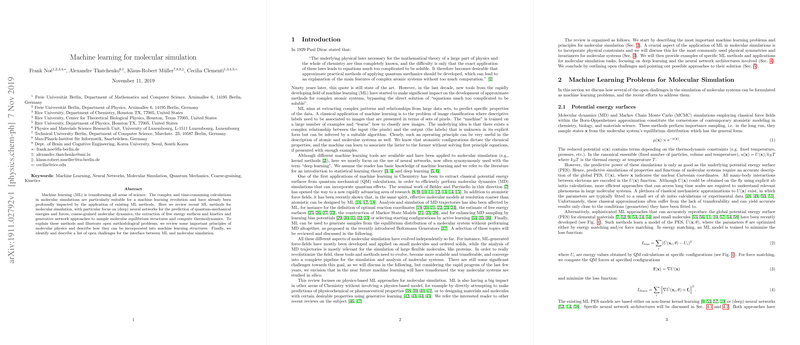Overview of Machine Learning for Molecular Simulation
This paper presents an extensive review of how ML methodologies are shaping the field of molecular simulations. The complexity involved in molecular simulations makes them highly amenable to ML innovations, as these methods can significantly enhance the efficiency and accuracy of such simulations.
Key Contributions
The paper explores a variety of ML techniques applied to different molecular simulation tasks, including:
- Energies and Forces: Neural networks have shown promise in replicating complex potential energy surfaces usually derived from high-dimensional quantum mechanical data.
- Coarse-grained Molecular Dynamics (MD): ML approaches help design effective molecular models at different resolutions. These methods are employed to develop models that are both scalable and transferable.
- Free Energy Surfaces and Kinetics: ML algorithms are utilized for learning free energy landscapes and kinetic models. These tools are essential for capturing the thermodynamics of molecular systems and for understanding fundamental processes in chemistry and biology.
- Generative Models for Structure Sampling: Techniques such as Boltzmann Generators are explored for efficiently sampling molecular equilibrium structures without conventional MD.
Methodological Insights
The paper examines the application of deep learning, particularly neural networks, highlighting the importance of incorporating physical principles like symmetries and invariances into ML models:
- Roto-translational Invariance: Ensures the energies and forces are modeled accurately across different conformations.
- Permutation Invariance: Critical for modeling systems with identical particles, ensuring consistency across simulations involving symmetric substitutions.
- Energy Conservation: Ensures that predicted force fields are derived consistently from potential energy models.
The review also addresses the architecture of notable models such as Behler-Parrinello networks, SchNet, and VAMPnets, discussing how these architectures successfully integrate domain knowledge.
Challenges and Future Directions
Several persistent challenges in the application of ML to molecular simulations are identified:
- Accuracy and Scalability: Achieving precise energy and force predictions for large systems remains a significant hurdle. Current models must be both computationally efficient and capable of scaling to complex molecular systems.
- Long-ranged Interactions: Accurately modeling long-range interactions like electrostatics remains a critical challenge and is essential for faithful simulation of complex molecules.
- Transferability: Developing coarse-grained models that maintain their accuracy across diverse chemical environments is essential for practical applications.
- Kinetic Modeling: While ML can capture long timescale kinetics, integrating these models seamlessly with existing simulation frameworks to provide true predictive insights is still under development.
Conclusion
The paper suggests that the intersection of ML and molecular simulations is rapidly evolving, driven by improvements in both computational methodologies and hardware. The integration of ML methods has the potential to revolutionize molecular simulations, offering unprecedented insights into system dynamics and facilitating new discoveries in molecular sciences. Future developments are likely to make simulations more efficient and applicable across a broader range of scientific inquiries.
